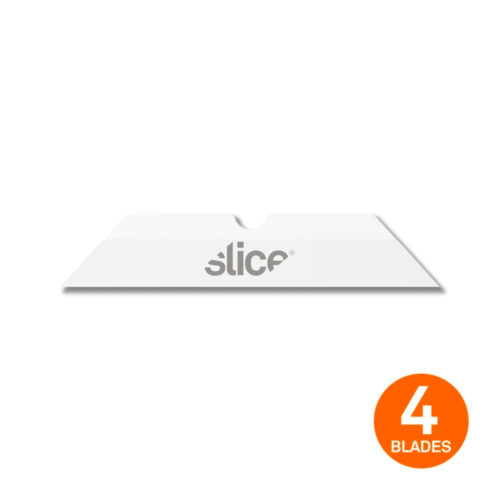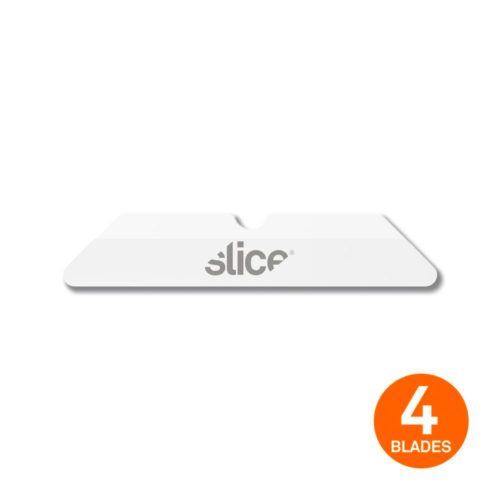Box Cutter Blades
The Sharpest Box Cutter Blade Is the Safest, Right?
Dull box cutter blades are notoriously unsafe because they require more pressure to move through material, which means an accidental slip will have more force behind it—and that force is typically headed straight toward the user. Because of this, people assume that the sharper a box cutter blade is, the safer it will be. Well, this isn’t true either. A blade really only needs a certain amount of sharpness to effectively cut material. Anything sharper cuts skin too easily.
So why would anyone make a blade that’s dangerously sharp? Traditional blades are made of metal, which dulls very quickly. If manufacturers sharpened metal blades only enough to cut effectively, they would dull so quickly that they’d be virtually useless. That’s why metal blades start off overly sharp. This method prioritizes product lifespan over user safety.
Unfortunately, many ceramic blade manufacturers simply copy metal blade designs, sharpening their blades to dangerous levels, too. Slice® is the only company with a finger-friendly® blade edge that is safe to the touch.
Which Slice Tools Take the Box Cutter Replacement Blades?
It’s no surprise that these small box cutter blades fit in our box cutters, but Slice also has other handles that are designed, from the ground up, to fit our box cutter blade dimensions perfectly. These include our pen cutters (manual and auto-retractable models available) and our Mini Cutter. The Mini Cutter is a small, auto-retractable multi-use tool. We’re currently working on a version with manual retraction, expected to be ready in late 2018.
How Long Will This Box Cutter Blade Last?
The lifetime of any blade depends on how frequently it’s used, and on what sort of material it’s cutting. However, independent third-party testing has shown that Slice blades last up to 11.2 times longer than comparable steel blades. Our customers tell us, too, that facilities have gone from replacing blades once a week to once in several months. For example, Jeremy Coyle at Menasha’s Neenah, WI, plant estimates, “I have made 30,000 to 40,000 cuts with [the Slice box cutter] before having to change the blade.” Keep in mind, too, that each blade is double sided, so once the first end is too dull, you can flip the blade over for a fresh edge. You’ll never need to look up how to sharpen box cutter blades again.
Should I Choose a Rounded-Tip or Pointed-Tip Box Cutter Blade?
Choosing the best box cutter blades for you will depend on your priorities and what materials you’re cutting. Some materials, for example, require the blade to initiate the cut with a puncturing action: flexible plastic films, fibre-reinforced bags, and fabrics, for example. Many other materials don’t need a pointed-tip blade, and of course a rounded tip is another safeguard against accidental punctures. So if safety is your primary concern, and you’re cutting corrugated, foam core board, or clamshell packaging, for example, a rounded tip is probably your best bet. Regardless of which blade you choose, it’s important to hold Slice handles properly to achieve the most effective cutting depth and ergonomic angle.
How Do I Install New Box Cutter Replacement Blades?
The procedure for how to change a box cutter blade is slightly different for each handle that we make, but in every case we’ve made sure that you don’t need any extra tools to do it.
Box Cutters: 10503 and 10400
Changing a box cutter blade on these tools starts with finding the grooved tab on the left side of the tool’s tip. Press the tab and push it forward. It should pop the tip right off the box cutter. At that point, the blade and its housing will be exposed. Simply pull the blade out and either flip it over end-for-end to start using the other blade tip, or replace the whole thing with a new blade. The cutter’s tip slides right back into place and you’re ready to go.
Pen Cutters: 10512 and 10513
Slice pen cutter tips twist off. First, locate the indicator notch just above the slider. When the two notches are lined up, the tool is closed and ready to cut. To remove the cap, hold the tool so the tip faces away from you and twist the cap to the right to remove it. Once the cap is off, extend the blade fully so you can remove and replace the current blade.
Mini Cutter: 10514
On the back of the Mini Cutter, you’ll see a circular cap with a notch, as well as an icon of a lock. If the notch is pointing to the lock, the tool is closed and ready to cut. To remove the cap, push your thumbnail into the notch and twist the cap counter clockwise. This separates the two halves of the Mini Cutter and reveals the housing for our box cutter replacement blades. Remove the current blade and either flip it over for a fresh edge or replace it with a new blade. Then line up both halves of the cutter and twist the cap back into the locked position.
Once you’ve changed the blade on any of these tools, box cutter blade disposal is made easier by the Slice finger-friendly grind. No sharps disposal box is necessary and our box cutter blades are 100 percent recyclable where facilities exist.


